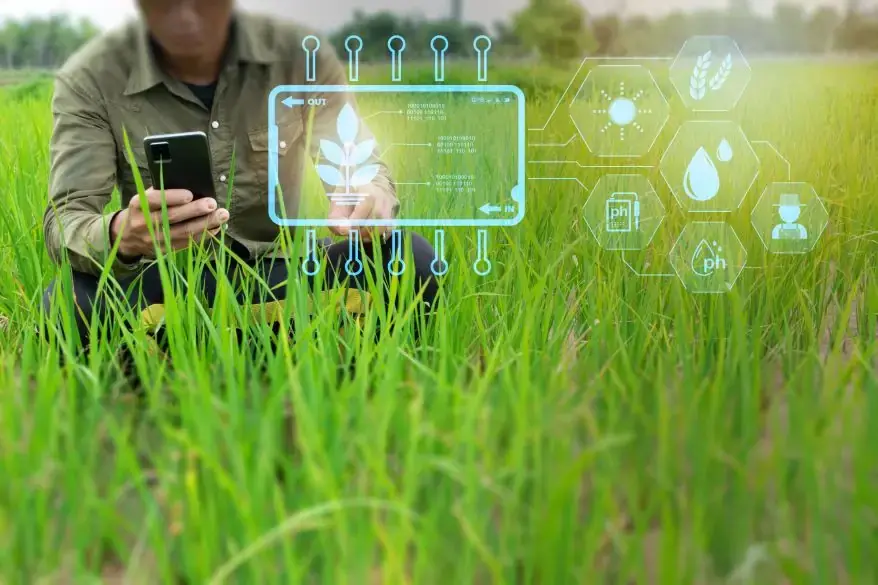Smart Fields: Technological Role in Crop Scouting
Every system, plant, or software is efficient and makes a profit only if it is healthy and works properly. And sometimes, when you notice that something goes wrong, it can be too late. So does farming. Timing is crucial, and to ensure that there are no issues or defects that may ruin the entire crop, field scouting is essential.
Like any organism, fields require regular check-ups. And if, decades ago, agronomists had to walk and manually inspect every piece of land to detect any deviations, today they can remotely observe plant conditions and spot early signs of trouble. Catching diseases or weeds makes a difference between a healthy yield and severe losses.
But scouting is not just about detecting pests. With advanced crop monitoring solutions, you can know your land better, track the vegetation stage of crops, and even know what’s happening next door on the closest site. This enables farmers to maintain the productivity and resilience of their farms against any potential threats that may arise at any time.
Why Every Acre Needs Eyes: The Case for Smarter Scouting
A decade ago, smart agriculture and monitoring tools were a luxury reserved for only the largest corporations. Today, even small-scale farmers in provinces and neighborhoods can utilize innovative tools to monitor the health of their crops in real-time, preventing minor plant issues from becoming costly disasters. And it’s essential not only for yield, but for profit and sustainability. So why should every farmer scout regularly?
- Early problem detection. Pests and diseases don’t need much time to spread. Days or even hours can be enough. Early detection allows you to take action before they wipe out entire sections of your field. According to the FAO report, pests are responsible for up to 40% of global crop losses annually, having a significant impact on the global economy, which costs over USD 220 billion per year.
- Make smarter decisions. Precise data received from field scouting helps farmers decide what action to take and when. And that’s not always about pest mitigation. With high-tech agricultural tools, farmers can schedule irrigation or targeted nutrition for effective treatment.
- Save money. The main goal for farmers is to earn more and spend less. Smart scouting can also solve this issue. Instead of spraying everything to fight pests, farmers can target areas that need treatment precisely. This simply cuts costs on chemicals and fuel.
- Protect the environment. We have games and other work, but we also need to care for the earth. We should use fewer chemicals and stop water from running off. This will protect the water and nature nearby.
Technology Behind the Eyes: Tools Powering Modern Crop Scouting
Not long ago, in the 1990s, farmers and agronomists walked through the fields, visually inspecting the crops for pests, diseases, nutrient deficiencies, and growth stages. They used only simple hand lenses, paper notes, and physical sampling. Usually, these observations were mainly qualitative and subjective and didn’t allow for quick reaction.
Today, drones, UAVs, AI, and satellites serve farmers on an everyday basis to address field issues. Massive differences, aren’t they? These tools have transformed traditional practices into a high-tech strategy for staying ahead of threats.
Satellites have made the most significant breakthrough in crop monitoring. Farmers can scan vast areas in minutes, receiving up-to-date images regularly, and reveal stress before it becomes visible on the ground.
How does this happen?
- Satellites equipped with multispectral sensors orbit the Earth and capture images of agricultural fields at various wavelengths (visible, near-infrared, etc.) at regular intervals.
- These images are transmitted to ground stations and uploaded to cloud servers for processing by specialized software, such as EOSDA Crop Monitoring. This software analyzes images using vegetation indices, such as NDVI, to assess plant health by measuring how plants reflect light differently when stressed compared to when healthy.
- Farmers use apps or websites to get this data. These tools show maps and send warnings. This helps them find trouble areas fast. They don’t need to check every part of their fields themselves. They can stop using scouting teams and going to the fields so often.
The way drones work is similar. They fly over a planned route and capture high-resolution images using multispectral, thermal, or RGB cameras. After the flight, the collected images are uploaded to cloud platforms, stitched into a detailed map, and processed by algorithms and platforms to pinpoint nutrient deficiencies, pests, or water stress with precision, right down to the individual plant. NDVI data, in particular, correlates strongly with plant biomass and chlorophyll content, which are essential indicators to prioritize nutrient management and treatment decisions.
In-field sensors
While drones and satellites provide a broad overview of crop conditions, they miss what’s happening right at the plant’s roots. That’s where in-field sensors come in. These tools on the ground check how wet the soil is, how hot or cold it is, how acidic it is, and how much food is in it. They do this very accurately, which pictures from above cannot do completely. These sensors always send data about the weather right there and the soil from particular places. This connects what we see from above to what is really happening where the roots are. Together, they create a more complete and accurate picture of crop health.
EOSDA Crop Monitoring: Smarter Scouting, Better Decisions
EOSDA Crop Monitoring is the exact platform that can assist farmers by providing understandable, clear, and precise information from satellites in a straightforward and non-technical form.
The system uses AI to look at satellite pictures. It has special methods to make easy-to-understand maps with colors. Farmers and experts can see problems that are found, how well plants are doing, how plants are growing, and what happened in the past. Based on this data, farmers can make data-driven decisions and prevent huge yield losses.
EOSDA Crop Monitoring uses clear satellite pictures and plant health measures like NDVI to quickly spot problems. These problems might include fungus, bugs, unwanted plants, or watering and feeding issues.
Even better, the EOSDA scouting app works offline. Farm workers can continue their tasks without an internet connection in the most remote fields of the Earth. Their data syncs once they’re back online. This flexibility enables teams to stay productive in areas where other equipment is inaccessible or too expensive to use.
The Road Ahead: What’s Next for Smart Crop Scouting
Generally, smart crop scouting appears promising and has the potential to become one of the most high-tech industries on the market. Firstly, it includes satellite imagery, drones, field sensors, and weather stations. Secondly, with the development of AI and blockchain, the entire scouting system can be automated, minimizing the risk of human error at every stage of the process.
For instance, in 2023, the global smart crop scouting market was valued at $4.69 billion. According to research, it is expected to reach $19.55 billion by 2032, growing at a CAGR of 13.86%. This surge is driven by increasing food demand, declining labor availability, and the growing need for sustainable practices. And while barriers such as cost and digital literacy exist, smart scouting tools offer enormous potential to reduce waste, boost yields, and create resilient food systems worldwide.
Additionally, to stay updated with the latest developments in STEM research, visit ENTECH Online. Basically, this is our digital magazine for science, technology, engineering, and mathematics. Furthermore, at ENTECH Online, you’ll find a wealth of information.






